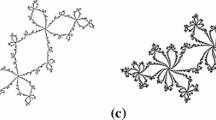Abstract
The problem of binary factorization of complex patterns in recurrent Hopfield-like neural network was studied by means of computer simulation. The network ability to perform a factorization was analyzed depending on the number and sparseness of factors mixed in presented patterns. Binary factorization in sparsely encoded Hopfield-like neural network is treated as efficient statistical method and as a functional model of hippocampal CA3 field
*This work was supported by grants Grant Agency of Czech Republic No. 201/01/1192 and 201/00/1031
Access this chapter
Tax calculation will be finalised at checkout
Purchases are for personal use only
Preview
Unable to display preview. Download preview PDF.
Similar content being viewed by others
References
Amit, D.J., Gutfreund, H. & Sompolinsky, H. (1987). Statistical mechanics of neural networks near saturation. Ann. Phys.,173, 30–67.
Amari, S. & Maginu, K. (1988). Statistical neurodynamics of associative memory. Neural Networks, 1, 63–73.
Amari, S. (1989). Characteristics of sparsely encoded associative memory. Neural Networks, 2, 451–457.
Buzsaki, G. (1996). Hippocampo-neocortical dialogue. Cerebral Cortex, 6, 81–92.
Frolov, A.A. & Muraviev, I.P. (1993). Informational characteristics of neural networks capable of associative learning based on Hebbian plasticity. Network, 4, 495--536.
Frolov, A.A., Husek, D. & Muraviev, I.P. (1997). Informational capacity and recal quality in sparsely encoded Hopfield-like neural network: Analytical approaches and computer simulation. Neural Networks, 10, 845–855.
Gifi, A. (1990). Nonlinear Multivariate Analysis. New York: John Wiley & Sons.
Hopfield, J.J. (1982). Neural network and physical systems with emergentcollective computational abilities. Proc. Natl. Acad. Sci. USA, 79, 2544–2548.
Marr, D. (1970). A theory of cerebral neocortex. Proc R Soc Lond, B, 176, 161–234.
Marr, D. (1971). Simple memory. A theory of archicortex. Phil Trans R Soc Lond, B, 262, 24–81.
McDonald, R.P. (1985). Factor Analysis and Related Methods. New Jersey: Lawrence Erlbaum Associates, Publisher.
Perez-Vicente, C.J. & Amit, D. (1989). Optimized network for sparsely encoded patterns. J. of Physics A: Math. Gen., 22, 559–569.
Author information
Authors and Affiliations
Editor information
Editors and Affiliations
Rights and permissions
Copyright information
© 2002 Springer-Verlag Berlin Heidelberg
About this paper
Cite this paper
Husek, D., Frolov, A.A., Rezankova, H., Snasel, V. (2002). Application of Hopfield-like Neural Networks to Nonlinear Factorization. In: Härdle, W., Rönz, B. (eds) Compstat. Physica, Heidelberg. https://doi.org/10.1007/978-3-642-57489-4_22
Download citation
DOI: https://doi.org/10.1007/978-3-642-57489-4_22
Publisher Name: Physica, Heidelberg
Print ISBN: 978-3-7908-1517-7
Online ISBN: 978-3-642-57489-4
eBook Packages: Springer Book Archive




